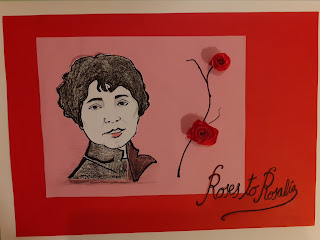She lived in Ortoño (Padrón) during her first years with her father´s sisters. At 5 she went to live with her mother, first in the town of Padrón and later in Santiago.
Highly educated and expected to write in Spanish only, she took the bold, unconventional step of writing her poems in the Galician language. So, her writings in Galician are the beginning of the "Rexurdimento" ("Galician Literature Renaissance"), along with Manuel Curros Enríquez and Eduardo Pondal.
In 1856 she went to Madrid.There she met Manuel Martínez Murguía, a Galician historian and journalist (and later her editor). They married in 1858. The couple had seven children.Manuel M. Murguía (17 May,1883, Arteixo) had many important positions: as Head of the "Arquivo Xeral de Galicia", Cronista Xeral do Reino, Co-editor of "La Patria Gallega", the Founder of the "Galician Academy"... This made the family move to different places ( Madrid, Santiago, Simancas, A Coruña...).
Rosalía is buried in the "Panteón de galegos Ilustres" (Pantheon of Illustrious Galicians) in Santiago.Her last residence (Padrón) became her House-Museum (since 1972).
In 1857, in Madrid, she wrote "La Flor", a book of poetry in Spanish.In 1863, May 17, she publised her first collection of poetry in Galician, "Cantares Gallegos" (Galician Songs). One hundred years later, this date, 17 May, became the "Día das Letras Galegas" (Galician Literature Day),
In 1880, she wrote the poetry book "Follas Novas" (while living in Simancas).
In between, she wrote several books in Spanish. Prose: "La hija del mar", for example. Poetry: for example "En las orillas del Sar", which was her last book (1884, in Padrón).
GOOD-BYE RIVERS, GOOD-BYE FOUNTAINS
(Sings:Amancio Prada)
A Rosalía ( translation by Eduardo Freire Canosa) (sings: Luis Emilio Batallán)
A ROSALÍA (by Curros Enríquez )
I watched her go past
Along the shoreline,
A song on her lip.
On the forehead a star,
And saw her so alone
In the endless night
That I yet prayed for the poor disturbed
woman,
I who have no one to pray for me!
The people´s muse
I saw pass by
Devoured by wolves,
Devoured she died...
To her belong the bones
You are going to preserve.
Ah, pity those who bear a star on the brow!
Ah, pity those that carry a song on their lip!



























